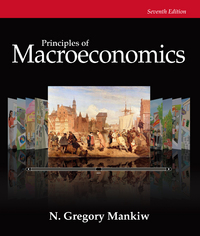Answered step by step
Verified Expert Solution
Question
1 Approved Answer
max ln(c1)+ln(c2) c1 ,c2 c1+ c2 =y1+ y2 t1 t2 1+r 1+r 1+r The recommendation again is that you start by setting up the Lagrangian
max ln(c1)+ln(c2) c1 ,c2 c1+ c2 =y1+ y2 t1 t2 1+r 1+r 1+r The recommendation again is that you start by setting up the Lagrangian of this maximization problem and take FOCs to find the Euler equation. Then, use the lifetime budget constraint to leave the Euler equation only in terms of either c1 or c2 (whatever you find easier). 4. Now, to see the Ricardian Equivalence in practice, let's give some specific values to the previous question. Suppose that = 1 and r = 1 . 10 a Use the information from Table 1 to find the optimal consumption in periods 1 and 2 Table 1: Two-period model with taxes Variable Value y1 100 y2 110 t1 10 t2 11 b Now assume that the government pretends to stimulate the economy by lowering taxes in period 1, so that now t1 = 5. If government spending has not changed, what would be the level of taxes in the second period to maintain a balanced government budget? Hint: Remember that the government's budget constrain is the following: G1+ G2 =T1+ T2 1+r 1+r To simplify the analysis, you may assume that there is only one individual in the economy
Step by Step Solution
There are 3 Steps involved in it
Step: 1

Get Instant Access to Expert-Tailored Solutions
See step-by-step solutions with expert insights and AI powered tools for academic success
Step: 2

Step: 3

Ace Your Homework with AI
Get the answers you need in no time with our AI-driven, step-by-step assistance
Get Started


